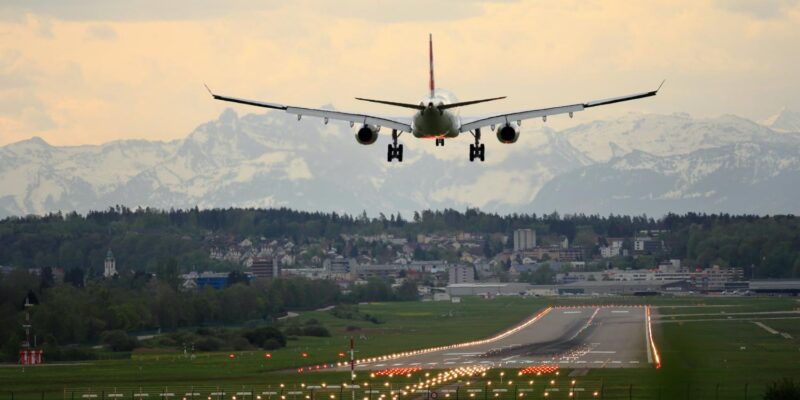Trade-offs for take-off: domestic aviation in a post-pandemic world
Several European governments have provided support to their national airlines and airports amid the COVID-19 pandemic. At the same time, they have committed to a green recovery, pledging to decarbonise their domestic transport sectors in order to reach their net-zero goals. What decisions and trade-offs might governments need to make in order to support domestic aviation and meet their environmental targets in a post-pandemic world?
Over the past year, a number of European governments have provided support to national airlines and airports, as aviation has been one of the most dramatically affected sectors by the COVID-19 pandemic. At the same time, governments have made pledges for a green recovery and commitments to decarbonise their domestic transport sectors in order to reach their net-zero goals. This is especially relevant to domestic aviation, given its high carbon emissions compared to other modes of transport, and the challenges of decarbonisation given the currently available technologies. However, as domestic aviation is also vital in supporting economic growth and social mobility by providing regional connectivity, governments face a trade-off between reducing emissions and providing that connectivity. This article considers the decisions and trade-offs made by national governments in Europe, including in the UK, France, Austria and Germany, with respect to providing financial support to the sector and achieving net-zero objectives in order to consider what domestic aviation may look like in a post-pandemic world.
The impact on domestic aviation
While domestic aviation has not suffered as much as international aviation from travel restrictions as a result of COVID-19, domestic air traffic movements in Europe at the end of 2020 were 50% lower on average than the equivalent week in 2019.1 As international aviation requires coordination between different countries and will depend on travel restrictions and vaccine rollout—which is occurring at very different speeds around the world—it is likely that domestic traffic will also see a faster recovery than international traffic.
Although domestic aviation makes up a low proportion of domestic transport emissions (less than 1% in the UK),2 aviation generates more greenhouse gas (GHG) emissions per mile than any other transport mode. For example, a passenger travelling from London to Edinburgh by plane would generate 144kg of GHG emissions while the same journey by train would result in only 29kg of emissions.3 All of these emissions count towards a country’s carbon budget and therefore its path to net-zero.
There have been calls for financial support to airlines during the pandemic to be linked to environmental conditions, especially when viable alternatives (such as rail) exist. In addition, many countries have pledged green measures in their recovery plans from the pandemic. However, there have also been concerns raised that these emergency support packages are not the right tool for achieving environmental targets, and that now is not the right time with the industry in such a precarious position. European governments have so far responded with different approaches when considering these issues.
Varying government approaches
At the end of 2020, the UK government announced its ten-point plan for a green recovery to ‘build back better from coronavirus’. At the same time, the Climate Change Committee advised that in order for the UK to meet its 2050 net-zero goal, it will need to reduce overall aviation emissions.4 While the UK government has not provided the extensive support to the aviation sector that has been provided by a number of other European countries,5 it has recently announced that it plans to cut air passenger duty (APD) on domestic flights to help the airline industry and boost connectivity across the UK in line with its ‘levelling up’ agenda. The proposals include measures such as reintroducing a return leg exemption or halving the current level of £13 per domestic flights. The government has announced a consultation and stated that it ‘will explore new requirements to offset emissions and in parallel continue to decarbonise aviation’.6
While the UK’s proposal was welcomed by the airline industry, as the reduction in APD is expected to encourage more demand for domestic travel, it has attracted criticisms from an environmental perspective, with organisations such as Greenpeace contrasting the reduction in APD to the recent rail fare rise and fuel duty freeze.7 The UK government has justified the proposals due to the need to better connect all parts of the UK in the aftermath of both the COVID-19 pandemic and the collapse of Flybe in 2020, which resulted in a loss of domestic routes.
In contrast, a number of European governments have taken different approaches with respect to their domestic aviation sectors.
The French government provided a significant bailout package to Air France in 2020, which included a number of environmental conditions. For example, the government included a requirement for Air France to scale back its domestic network where there is a viable rail alternative with a journey duration of under 2.5 hours (in addition to provisions for reducing emissions from domestic flights by 50% and using 2% of sustainable fuels by 2025).8 This means that Air France can no longer compete with high-speed TGV trains for routes such as Paris Orly to Lyon, Bordeaux or Nantes.9 Critics voiced concerns that regional connectivity will suffer as a result,10 and have noted the potential unintended consequences on competition if these rules are not imposed on other airlines as well.11 In contrast, environmental groups want to see an extension of the law to include rail substitutes within four hours.
The Austrian government similarly imposed environmental measures as part of its COVID-19 rescue package for Austrian Airlines in 2020. This included an increase in passenger taxes on short-haul flights and the introduction of a special tax of €30 on airline tickets for flights of less than 350km. This measure was introduced to encourage a modal shift for journeys where there is a train alternative that takes less than three hours.12 In addition, the Austrian government has introduced a minimum price on airline tickets of €40, which must reflect all relevant taxes and fees.
Prior to the start of the pandemic, the German government had already presented a law as part of its Climate Protection Programme to increase the air traffic levy from €7.50 to €13.03 per ticket (which came into effect in April 2020)13 to discourage short-haul flights while at the same time reducing VAT on long-distance rail tickets, making rail travel 10% cheaper.14 More recently, Lufthansa unveiled a partnership with Deutsche Bahn to offer ‘train to flight’ services in order to encourage people to travel by rail instead of flying for shorter journeys.15 This cooperation between rail and air is seen as an important move to increase connectivity and reduce emissions as short-haul flights are often feeders to long-haul flights. However, unlike for Air France, the German government’s rescue package for Lufthansa in 2020 did not include any concrete environmental conditions.
It is notable that in contrast to France, Austria and Germany, Italy’s recovery fund does not make reference to its domestic aviation sector, though it does mention further developments of high-speed rail and improving rail connections across regions. In addition, the aid packages approved by the Commission to support Alitalia for the damages it experienced as part of the COVID-19 pandemic in 2020 were not linked to specific environmental measures.16
Future priorities
Given that emissions from domestic aviation are included in countries’ national carbon budgets and that in many cases transport alternatives with significantly lower carbon footprints (such as rail) already exist, it is a comparatively easy area for governments to cut emissions. In the last year, we have seen a number of governments attach environmental conditions to bailout packages that involve increasing taxes or mandating the use of rail alternatives in order to reduce demand for short-haul flights. However, there are concerns over the impact that this might have on regional connectivity and the viability of the sector, and this tension has resulted in some countries (notably the UK) taking a different approach and proposing to stimulate demand for domestic aviation through reductions in APD.
The UK government’s recently launched consultation on APD does not explicitly address the tension between providing support for domestic aviation while at the same time meeting its net-zero objectives. Instead, the focus is on the options for restructuring APD, while a separate consultation will consider how to decarbonise the aviation sector through the use of new technologies, sustainable aviation fuels and the new UK Emissions Trading Scheme.17 This raises the question around the level of demand for domestic aviation that the government is seeking to restore following the pandemic (and whether a cut in APD is the right tool to achieve this). The trade-offs between regional connectivity, economic competitiveness and the environmental impacts of the domestic aviation sector will need to be explicitly taken into account when designing future policies.
1 See factsheets for November for the UK, Italy and Germany from Eurocontrol (2021), ‘COVID-19 impact on the European air traffic network’.
2 Department for Transport (2021), ‘Union Connectivity Review Interim Report’, March, p. 32.
3 Ibid., p. 21.
4 Climate Change Committee (2020), ‘The Sixth Carbon Budget – Aviation Sector Summary’, December.
5 For example, the Bailout tracker by Transport and Environment, Carbon Market Watch and Greenpeace (which collects publicly available data on government bailouts since the beginning of the COVID-19 pandemic), shows that the UK agreed to a total of 5bn Euros in loans to IAG (British Airways) and Easy Jet, compared to around 10bn Euros by Germany to Lufthansa, TUI Group (Germany) and 7bn Euros by France to Air France (with an additional 3bn Euros recently announced).
6 GOV.UK (2021), ‘Move to boost transport connections across the whole of the UK’, 10 March.
https://www.gov.uk/government/news/move-to-boost-transport-connections-across-the-whole-of-the-uk
7 Financial Times (2021), ‘Johnson backs cut in air passenger duty to aid UK domestic flights’, 9 March.
https://www.ft.com/content/70bbc71d-50f5-49fd-97d3-36625146e7d9
8 There is however an exception for transfers and connecting flights (for example to Paris CDG). Source: Les Echos (2020), ‘Air France : l’aide de l’Etat conditionnée à une réduction des vols intérieurs’, April.
9 BNN Bloomberg (2020), ‘Airline bailouts point to greener travel—and higher fares’, 9 June.
10 Air Journal (2021), ‘Aéroports et climat : l’avenir des territoires sacrifié selon l’UAF’, 16 March.
11 French Parliament is currently voting on a Climate Law that would impose these same restrictions on all carriers for domestic flights with a rail equivalent under 2.5 hours: https://reseauactionclimat.org/projet-de-loi-climat-lambition-en-decalage-avec-les-objectifs-et-lurgence-climatique/.
12 Welt (2020), ‘Österreich verbietet die 9,99-Euro-Billigstflüge’, 9 June.
13 Buzer.de (2020), ‘Änderung § 11 LuftVStG vom 01.04.2020’.
14 Key measures for the German Climate Protection Programme: https://www.bundesregierung.de/resource/blob/975226/1673502/855f58eed07bcbbd697820b4644e83a7/2019-09-20-klimaschutzprogramm-data.pdf?download=1.
15 International Railway Journal (2021), ‘DB and Lufthansa announce expansion to Lufthansa Express Rail’, 9 March.
16 European Commission (2020), ‘State aid: Commission approves €73 million of Italian support to compensate Alitalia for further damages suffered due to coronavirus outbreak’, 29 December.
17 HM Treasury (2021), ‘Aviation tax reform: consultation’, March, pp. 6–7.
Download
Related

Economics of the Data Act: part 1
As electronic sensors, processing power and storage have become cheaper, a growing number of connected IoT (internet of things) devices are collecting and processing data in our homes and businesses. The purpose of the EU’s Data Act is to define the rights to access and use data generated by… Read More

Adding value with a portfolio approach to funding reduction
Budgets for capital projects are coming under pressure as funding is not being maintained in real price terms. The response from portfolio managers has been to cancel or postpone future projects or slow the pace of ongoing projects. If this is undertaken on an individual project level, it could lead… Read More

